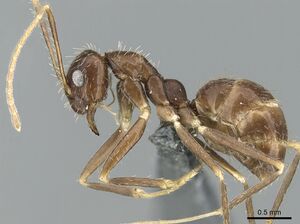Paratrechina ankarana
| Paratrechina ankarana | |
|---|---|

| |
| Scientific classification | |
| Kingdom: | Animalia |
| Phylum: | Arthropoda |
| Class: | Insecta |
| Order: | Hymenoptera |
| Family: | Formicidae |
| Subfamily: | Formicinae |
| Tribe: | Lasiini |
| Genus: | Paratrechina |
| Species: | P. ankarana |
| Binomial name | |
| Paratrechina ankarana LaPolla & Fisher, 2014 | |
This species is restricted to Madagascar were it is found in dry forest habitats.
Identification
Dark brown, with cuticle giving a faint greenish-blue reflection; propodeum with fine striations across surface; SI less than 195.
Keys including this Species
Distribution
Distribution based on Regional Taxon Lists
Malagasy Region: Madagascar (type locality).
Distribution based on AntMaps
Distribution based on AntWeb specimens
Check data from AntWeb
Countries Occupied
| Number of countries occupied by this species based on AntWiki Regional Taxon Lists. In general, fewer countries occupied indicates a narrower range, while more countries indicates a more widespread species. |

|
Estimated Abundance
| Relative abundance based on number of AntMaps records per species (this species within the purple bar). Fewer records (to the left) indicates a less abundant/encountered species while more records (to the right) indicates more abundant/encountered species. |

|
Biology
Castes
Images from AntWeb
     
| |
| Worker. Specimen code casent0906651. Photographer Estella Ortega, uploaded by California Academy of Sciences. | Owned by CAS, San Francisco, CA, USA. |
   
| |
| Worker. Specimen code casent0906652. Photographer Estella Ortega, uploaded by California Academy of Sciences. | Owned by CAS, San Francisco, CA, USA. |
Nomenclature
The following information is derived from Barry Bolton's Online Catalogue of the Ants of the World.
- ankarana. Paratrechina ankarana LaPolla & Fisher, 2014: 41, figs 1-3 (w.) MADAGASCAR.
Holotype worker. MADAGASCAR: Province Antsiranna, Rés. Spéc. Ankarana; 22.9km 224° SW Antivorano Nord; 80 m; 12°55'S, 49°7'E; 10-16.ii.2001; Fisher et al.; CASENT0454372 (CASC).
Paratypes. 6 paratype workers with the same locality information as the holotype (CASC, USNM); 9 paratype workers, Antsiranna, Rés. Spéc. Ankarana; 22.9 km 224° SW Antivorano Nord; 210 m; 12°52'S, 49°14'E; 16-21.ii.2001; Fisher et al. (BMNH, CASC, PBZT, USNM).
Description
Worker
(n=6) TL: 2.60–2.84; HW: 0.60–0.63; HL: 0.66–0.72; EL: 0.18–0.20; SL: 1.10–1.17; PW: 0.42–0.46; WL: 1.01–1.07; GL: 0.90–1.14; PFL: 0.80–0.90; CI: 85–92; REL: 27–29; REL2: 31–33; SI: 184–191; SMC: 24–30; PMC: 3–6; MMC: 3–4.
Dark brown; antennae lighter with trochanters yellow to white; cuticle smooth and shiny, except on propodeum which posseses fine striations across surface; under microscrope view cuticle has a faint greenish-blue reflection; abundant macrosetae across scapes, head, pronotum, mesonotum, and gaster; scapes with short pubescence. Head ovate; posterolateral corners rounded with complete posterior margin; midpoint of eyes at approximately midline of head; eyes convex; 3 small ocelli present; mandibles with 5 teeth; apical tooth the longest, 3rd tooth from apical shortest, remainder about the same size; outer mandibular surface with slight striations across surface. In lateral view, pronotum rises in a straight margin towards mesonotum with only slight convexity towards mesonotal margin; propodeum large and bulbous, making division between dorsal and declivitous faces difficult; metanotal suture with distinct impression that extends down along the mesopleural/metapleural margin; mesopleuron with darkened ridge along impression.
Etymology
The specific epithet is derived from the name of the reserve where the species was found.
References
- Boudinot, B.E., Borowiec, M.L., Prebus, M.M. 2022. Phylogeny, evolution, and classification of the ant genus Lasius, the tribe Lasiini and the subfamily Formicinae (Hymenoptera: Formicidae). Systematic Entomology 47, 113-151 (doi:10.1111/syen.12522).
- LaPolla, J.S. & Fisher, B.L. 2014. Then there were five: a reexamination of the ant genus Paratrechina (Hymenoptera, Formicidae). ZooKeys 422, 35–48 (doi: 10.3897/zookeys.422.7779).
- Tseng, S.-P. 2020. Evolutionary history of a global invasive ant, Paratrechina longicornis (Dissertation_全文 ). Ph.D. thesis, Kyoto University.
References based on Global Ant Biodiversity Informatics
- Huong N. T. T., P. V. Sang, and B. T. Viet. 2015. A preliminary study on diversity of ants (Hymenoptera: Formicidae) at Hon Ba Nature Reserve. Environmental Scientific Conference 7: 614-620.

